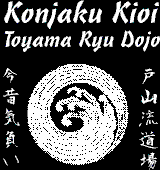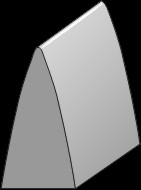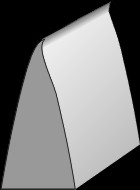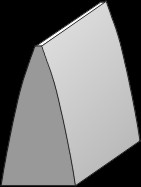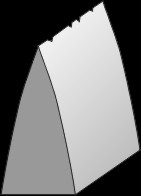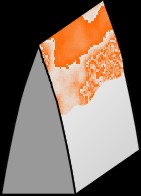 |
Toyama Ryu Batto Do Konjaku Kioi Dojo (Ancient and Modern Fighting Spirit Dojo) |
5980 66th St N Suite M St Petersburg FL 33709 Email: info@toyama-ryu.com Phone: 727-329-9679 |
|
Home
|
Is my sword sharp?Everyone always asks if their katana is sharp enough. There are plenty of questionable tests like cutting paper, shaving the hair off your arm, or scraping your thumb on the edge with a sage expression on your face. If you are asking the question, you probably already know the answer. It is important to understand what makes your katana dull. I have found six things you should watch out for. These are Abrasion, Rolled Edge, Flattened Edge, Chipped Edge, Corrosion, and Self Mutilation. I cover each of these in their own section. If you are wondering about a new sword, you should also check out the edge geometry section. A good sharpening should last 6 months to a year, but every sword is different. The dojo store offers full sharpening, repair, and customization services to keep your katana in top working order. It also has a wide range of Japanese Water Stones and holders. Surface PolishThe surface polish of a katana is as important to cutting as the geometry. It is especially important for the durability of the edge and surface friction of the blade. An edge from a coarse grit stone may feel very sharp and cut well for the first few times, but it will quickly become dull. A rough finish will also bind up in the target. Polishing and sharpening a katana are the same process. For swords that will see real use, a full cosmetic polish is not needed. Who wants to pay $2000 every year to keep your sword sharp. A sharpening polish leaves some scratches on the surface and skips the purely cosmetic steps. Abrasion
|
| Particle Size (Microns) |
US Grit |
Japanese Grit |
Examples |
| 0.5 | 12000 | 25000 | Chromium Oxide Polishing Compound, Moor White Ceramic |
| 1 | 5000 | 10000 | Honyama Awasi (Brown Stone), Linde C Compound (Aluminum Oxide Powder) |
| 2 | 3000 | 6000 | Karasu (Blue Stone), Awasi Toshi |
| 3 | 2000 | 4000 | Uchigumori, Extra Fine White Ceramic, Green Chrome Rouge, Spyderco Extra Fine Ceramic |
| 6 | 1200 | 2500 | Ao-To (Blue Stone), Spyderco Fine Ceramic |
| 10 | 1000 | 2000 | Hard Black Arkansas, Extra-Fine Diamond Hone, Lansky Ultra-Fine Hone |
| 15 | 800 | 1500 | Koma-Nagura, Hard White Arkansas, Extra Fine Diamond, Medium Ceramic, Moor Black Ceramic |
| 20 | 600 | 1000 | Soft Arkansas, Lansky Fine Hone, Ultra Fine Scotch-Brite Pad, Spyderco Medium Ceramic |
| 25 | 480 | 800 | Chu-Nagura, Washita Stone, Fine Diamond |
| 35 | 320 | 500 | Kaisei (Natural Sandstone), Fine India, Medium Diamond, Super/Extra Fine Scotch-Brite Belt/Pad |
| 45 | 280 | 400 | Medium India, Fine Crystolon (Silicon Carbide), Coarse Diamond, Lansky Medium Hone |
| 60 | 220 | 300 | Binsui Coarse Stone, Extra Coarse Diamond Hone, Very Fine Scotch-Brite Belt/Pad |
| 80 | 180 | 260 | Fine Scotch-Brite Belt/Pad |
| 90 | 150 | 220 | Medium Crystolon (Silicon Carbide), Coarse India, Medium Scotch-Brite Belt/Pad |
| 110 | 120 | 180 | Arato (Natural Sandstone Or Carborundum), Lansky Course Hone |
| 150 | 100 | 150 | Coarse Crystolon (Silicon Carbide) |
| 180 | 80 | 90 | Lansky Extra Coarse Hone, Coarse Scotch-Brite Belt/Pad |
If a sword just needs to be touched up, I use six progressively finer grits from 800 to 12000 (Japanese). The polished surface is degraded if the edge is touched up with anything coarser.
Water Stones
Japanese water stones are either natural and artificial. Natural stones can be quite expensive, but artificial stones can be used for sharpening polish. About half the stone used in a full cosmetic polish can also be artificial, but some steps require specific natural stones. Artificial stones use a graded abrasive suspended in either a clay or ceramic media. The stones use water as a lubricant. A series of stones ranging from about 800 to 12000 grit are used to sharpen blades in good shape. If a blade is badly shaped or has chips to remove, stones down to 80 grit can be used. Water stones should be soaked for 15 minutes before use. Mixing baking soda in the water will help reduce corrosion of the blade during sharpening.
Copyright © 2006 by Konjaku Kioi Toyama Ryu Dojo, All rights reserved.
Samurai Swords
Iaito (Practice Swords)
Shinken (Cutting Swords)
Wakizashi (Short Swords)
Tanto (Daggers)
Japanese Weapons
Maintenance
Uniforms
Sharpening
Sword Repair
Martial Arts
Dictionary Your Name in Japanese
Dojo Stories
Tatami Targets
